
Latest News
- Hyundai E&C Becomes Key Player in the Nuclear Decommissioning Market
- Hyundai E&C Accelerates Global Nuclear Expansion into the U.S. Nuclear Market
- Hyundai E&C Shifts into High Gear to Enter Nordic Large-Scale Nuclear Market
- Hyundai E&C Strengthens Korea-Japan Cooperation in Energy Transition and New Growth Businesses
- Hyundai E&C Signals Green Light for Large-Scale Nuclear Power Plant Business in Europe
History of Korean Apartments through the Hyundai E&C Apartments
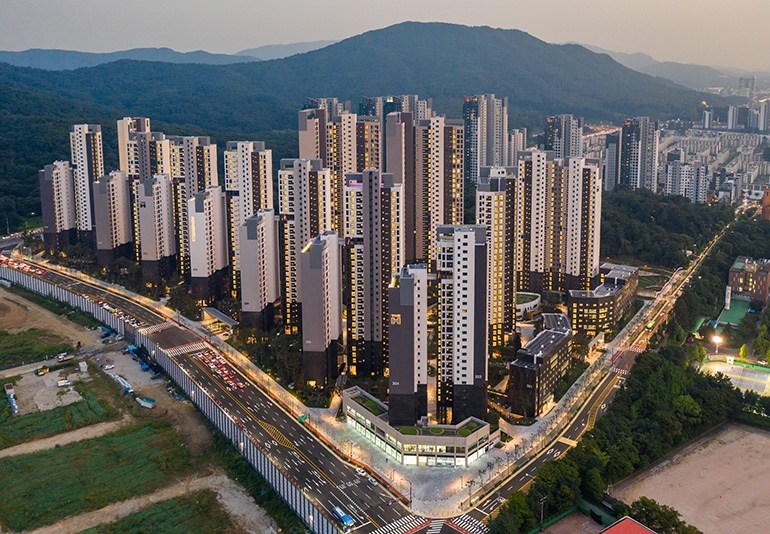
[ Let’s look into the Korean apartment development process through the history of Hyundai Engineering & Construction apartments. ]
The history of apartments began around the origin of Roman empire. Back then, the apartments called insula looked like store complex of nowadays. But with the decline of Roman empire, the insula became a thing of the past. After that, apartments reappeared in England during the industrial revolution. Since the second World War, with population increasing in cities around the world and urbanization accelerating, they became the living space, which could allow nations to efficiently make use of their land.
When did apartments appear in Korea? Our traditional living space was in the form of traditional Hanok and thatched houses. Let’s look into the changes Korean apartments went through via the apartment development history of Hyundai Engineering & Construction which was in charge of constructing the 1st generation apartments in Korea.
1960s, the First Complex Type Apartment, Mapo Apartments

[ Mapo apartments, which Hyundai Engineering & Construction participated in its construction, is Korea’s first complex type apartments. ]
Korea’s first apartment is known to be the 4-floor Eurim apartment in Chungjeong-ro, Seoul, built by the architect Toyoda in the 1930s. It had both stores and living space. The first of the complex type apartment we are used to is Mapo apartments, which were located in Dohwa-dong, Mapo-gu, Seoul, in 1964. Mapo apartments, which involved 5 construction companies including Hyundai Engineering & Construction, had 4 6-floor I type complexes and 6 Y type complexes; they were Korea’s very first complex type apartments. In consideration of the insufficient electricity and water back then, the buildings were built as 6 floor ones with individual heating facilities using briquet boilers.
The Origin of High Rise, Multi-complex Apartment Housing Culture, Hyundai Apartments
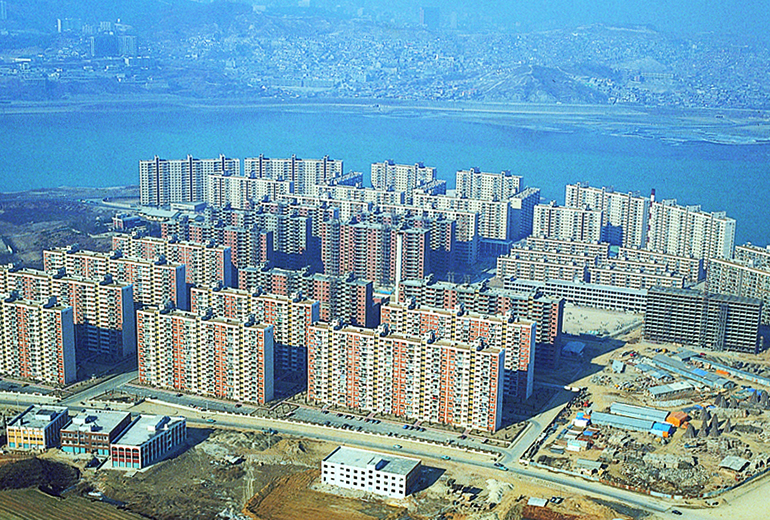
[ In the 1970s, when large-scale apartments became necessary, Hyundai Engineering & Construction built Hyundai apartments. ]
In the 1970s, with government-led industrialization accelerating, city population was surging and housing demand increased greatly, which naturally led to demand for large-scale apartments. This was when private housing business really started to take off. Hyundai Engineering & Construction built the Seobingo Hyundai apartments with the goal of ‘providing convenient and refreshing living space for the end users through quality construction.’ Seobingo Hyundai apartments were the first apartment project Hyundai Engineering & Construction independently led. From the building arrangement, material selection, landscaping, and additional facilities, Hyundai Engineering & Construction focused on realizing an optimum living environment that would satisfy the users’ taste. The successful sales of Seobingo Hyundai apartments led to the construction of Apgujeong Hyundai apartments. In mid-1970s, Apgujeong-dong was just a sandy field near the Han river, but with the 1st and 2nd Apgujeong Hyundai apartment complexes, the area began to look like a proper neighborhood. Apgujeong Hyundai apartments created the typical ‘Korean apartments’ through its harmony of living environment.
Simple exterior, dirt color based on the traditional belief ‘people need to step on earth,’ balcony structure that reminded one of front yards, and flat structure that took Korean lifestyle into consideration all led to the public’s huge appraise of the apartments being the best one of its time and great demand. Thanks to their great popularity, Apgujeong Hyundai apartments were constructed over 12 years since 1987 in 14 complexes with high rise apartments that were higher than 15 floors including around 6300 units, which led to the creation of ‘high rise-multi-complex’ apartment culture.
A Park within Your Living Space, Gui-dong Hyundai Prime
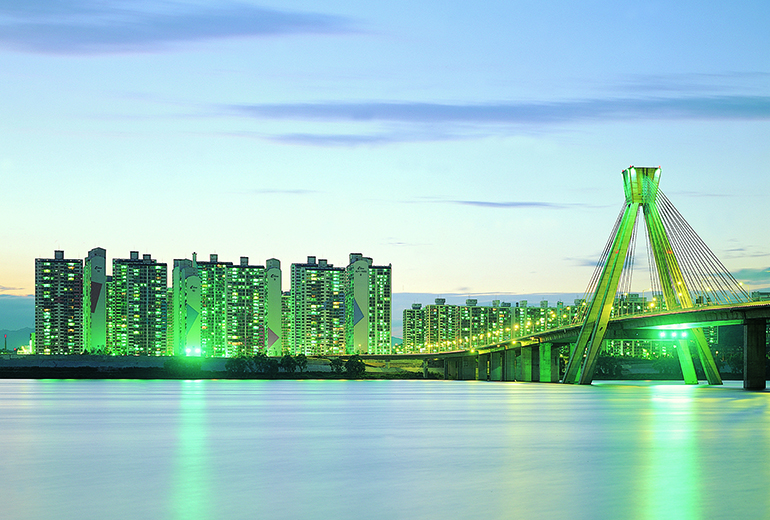
[ In mid-1980s, Hyundai Engineering & Construction began introducing apartments with greater customer service. ]
Hyundai Engineering & Construction’s apartment business went smoothly in the mid-1980s, and the demand for Hyundai apartments was also rising, establishing Hyundai Engineering & Construction’s reputation as a ‘reputable apartment brand.’ In the late 1980s, with the government’s ‘2 million housing construction plan,’ the apartment construction boom took place. Hyundai Engineering & Construction focused on upgrading customer service amidst the quantity-oriented competition.
A design competition was held in 1994 for housewives, and a customer service center was set up to establish a 24-hour defect reception system. From 1996, 8 apartments including Gui-dong Hyundai Prime underwent park construction within the complexes so that residents could enjoy the countryside mood and relaxing atmosphere within their apartment complexes. Such endeavors changed the public awareness of Hyundai Engineering & Construction apartments: from ‘solid, convenient apartments’ to ‘modern, sophisticated apartments.’
The Beginning of Brand Apartment Era, HILLSTATE
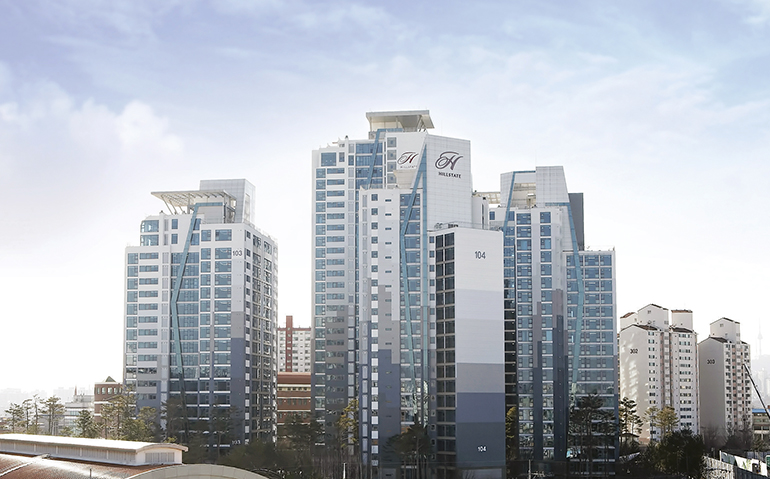
[ In the early 2000s, Hyundai Engineering & Construction’s apartment brand ‘HILLSTATE’ was created. ]
In the late 1990s, with apartment sales price liberalization and simultaneous sales system led to even more fierce competition in Korea’s apartment market. This ignited the cause for the rise of brand apartments. In July 2000, Hyundai Engineering & Construction built new apartments with 1092 units in 2 areas in Incheon and announced the beginning of brand apartment era with their ‘Hyundai Home Town’ brand. In September 2006, the ‘HILLSTATE’ brand was launched, which could realize Hyundai apartments’ ‘traditional value’ and ‘optimum value.’
The first HILLSTATE was the Seoul Forest HILLSTATE, which was introduced to the public in May 2009. It embodies all the aspects of luxury apartments Hyundai Engineering & Construction pursues. Exterior design, including the yacht-shaped dynamic exterior, reflected the characteristics of each apartment’s location landscape. Samseong-dong HILLSTATE, which was the ‘first gateway to Gangnam HILLSTATE,’ had hydroponics space with Jeju hackberry trees to create the ‘nature in the middle of city’ atmosphere, along with 10 other types of fruit trees for an orchard. New renewable energy system was also implemented for the first time to lead the way for eco-friendly/low-energy apartment construction.
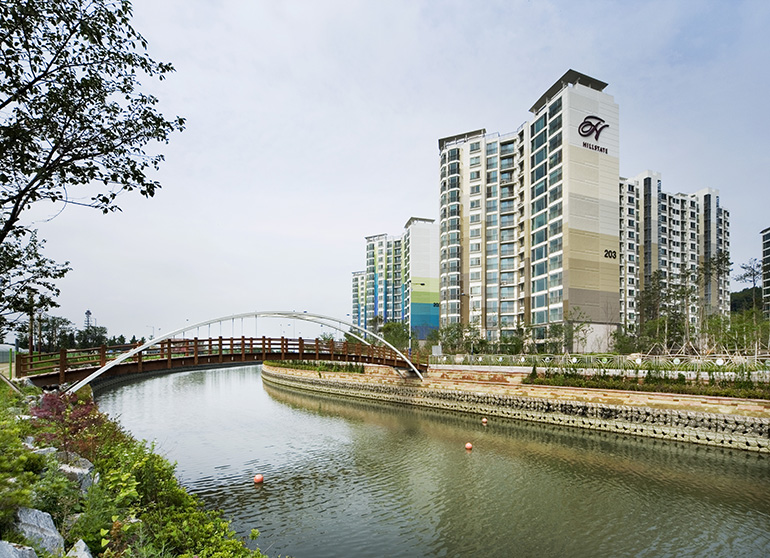
[ HILLSTATE established itself as Korea’s best brand apartments with its implementation of living trend and various housing products within the complexes. ]
Gimpo Gochon HILLSTATE, which was completed in April 2008, grabbed many people’s eyes as it was Korea’s first private city development project. Apartments with 2605 units and 9993 single-family houses were constructed near the Gochon station in Gimpo city. To continuously pursue the newness of the brand while also leading the apartment market, HILLSTATE has been announcing the ‘HILLSTATE style’ since 2015. Such efforts made it no.1 in brand evaluations carried out by 3 major apartment expert research institutions around the end of 2016 and early 2017.
Rare Premium Apartments, THE H

[ Recently Hyundai Engineering & Construction launched the premium apartment brand THE H, following HILLSTATE. ]
In April 2015, Hyundai Engineering & Construction introduced their premium apartment brand ‘THE H.’ THE H inherits the ‘H emblem,’ to maximize the brand asset they have been carrying, and attached the definite article ‘THE,’ which means ‘the only name for a prestige life’ to represent the rarity the brand carries. THE H was created to convey housing products and services that are like no other. More than 3 maximum, minimum, and only items are implemented while each complex involves differentiated design and construction. ‘THE H Honor Hills,’ which was introduced in August 2019, proposed strict product standards for premium living space and was popular for its high-class living services which included their A/S and resident only mobile applications. It set the bar for premium housing as providing Gangnam’s first independent terrace house.
The history of Korean apartments developed with industrialization. Hyundai Engineering & Construction has been proposing new living space along the way, in consideration of the trend of the times. As a result, it has been leading the Korean apartment market by constructing the first complex type apartments as well as a premium apartment brand THE H. Since 2018, they have been launching ‘H Series,’ which is housing product ideas that reflects the lifestyle trend. They have been developing housing products for ‘houses that the customers wish to live in’ by creating ‘H iForest,’ which is an indoor playground free from micro-dust, shared electronic bicycle ‘H Bike,’ etc. How will the Hyundai Engineering & Construction apartments evolve in the future? All are looking forward to future changes with great anticipation.

